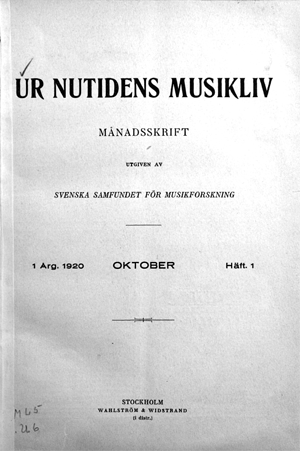Ur Nutidens Musikliv
RIPM Preservation Series: European and North American Music Periodicals (2021)

Founded in 1920 by the musicologist Tobias Norlind (1879-1947), Ur Nutidens Musikliv (From the Musical Life of Today) was envisioned to serve as a general music journal alongside of Norlind’s other journal, the Svensk tidskrift för musikforskning (STM), which he established in 1919. Each journal would serve a separate purpose.[1]
A summary of this journal was provided by Ingmar Bengtsson, here provided in translation from the original Swedish:[2]
"As early as April 7, 1920, the question of how the dual purpose [of general musical news and specialized musicology] could best be realized was resumed. It was decided to "next autumn publish a special section of the magazine, dealing with contemporary music life", provided that at least SEK 2,000 was received in government grants for the publication of STM. On July 1, it was decided that there would be a separate publication called "Ur Nutidens Musikliv" (UNM), which would be published every month and sent free of charge to members of the community.
Nowadays, UNM seems to have been forgotten and its existence in the years 1920-1925 is unknown even to several members of the community. A summary overview of the content of UNM may therefore be appropriate.
UNM started in the autumn of 1920. This first year only three issues were published (on a total of 102 pages), but in the future there were an average of eight issues per year, a few years up to twelve, which, however, through mergers became ten separate booklets. Each issue normally included a 16-page printout sheet.
The very first booklet from October 1920 is not representative of the scope but all the more so in the content. You will find there articles about music life especially in Stockholm and Gothenburg in the spring of 1920 (by P. Vretblad and J. Rabe) and a couple more articles on current events. This is followed by a number of note sections under the headings “From the Concert World” “From the Association World”, “Various music messages”, “Personal notes”, “Deaths in the music world”, “Swedish literature” and [foreign] “Music literature” etc.
Most of these headlines became standing columns in the following years and together with the overviews of the music life in the two largest cities and the numerous articles about individual artists give a remarkably full picture of the music life of that time. There were also regular "music letters" covering the music scene in selected foreign locations, mainly Berlin. Both the artist portraits and the note sections have very clear similarities with the design in the Svensk Musiktidning, and one of the society's earliest ambitions was to address its fallen mantle.
The most diligent of the donors was Norlind himself. His strong interest in the executor side, for "artist history" — a now not very common trait among musicologists — is documented in several other contexts, including in his Allmänt Musiklexikon. At UNM, this interest had the opportunity to flourish; here you also meet Norlind as a music reviewer. In addition, he is responsible for the majority of the book reviews and should have written several of the anonymous notices.
A central contribution in the first volume is Gunnar Jensen's article “Arnold Schönberg - a future musician” (1920: 2-3). In 1923, Jeanson returned with the contribution “Some guidelines in contemporary music”, seconded by Rabe with ”A tendency in modern music.” The article group must be described as for its time bold and perceptive. In 1920, Norlind's extremely enlightening debate post "Musicology at Swedish universities" also appeared (see further below). In 1921 and later, articles were contributed by several foreign writers, e.g. by G. Jean-Aubry on Debussy, A. Schweizer on Bach's St. Matthew Passion in Barcelona and R. Felber on Gustav Mahler. In part, these are original articles for UNM. The same year begins a series of birthday tributes (Stenhammar and Hennerberg 50 years, Elfrida Andrée 80 years etc.). From the 1922 vintage can be mentioned articles about Andreas Hallén and Ruben Liljefors, about Pfitzner, Reger and Tchaikovsky, about «Contemporary Italian music” (by G. M. Gatti) and about artists such as Chaliapin and Battistini. 1923 came with contributions on Peterson-Berger and Sibelius and an article on the Royal Opera in its 50th anniversary.
From 1924, fruits of Norlind's teaching began to benefit UNM: then influences in a series of issues Gereon Brodins “Swedish chamber music bibliography” and C.-A. Moberg's “Concerts in Stockholm a hundred years ago.” In other respects, the vintage has approximately the same character as the previous ones, but with these two contributions, the boundary between STM and UNM must be said to have become less sharp than originally intended. (Moberg's concert list also ended, as is well known in STM 1925.) 1925 began stately with a special Puccini number, in the next issue there is only an article about Signe Hebbe and a couple of note sections. But with that, UNM suddenly ceases."
[1] Håkan Lundström, “Svensk forskning i musik – de senaste 100 åren.” Svensk tidskrift för musikforskning 101 (2019): 5.
[2] Ingmar Bengtsson, “Svenska samfundet för musikforskning 50 år (1919-1968).” Svensk tidskrift för musikforskning 51 (1969): 16-17.
